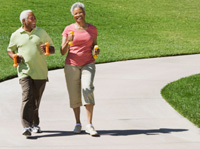6 in 10 Adults Now Get Physical Activity by Walking
 More people are walking but most do not get enough physical activity. Find out how we can make it easier for people to walk to the places they need and want to go.
More people are walking but most do not get enough physical activity. Find out how we can make it easier for people to walk to the places they need and want to go.
Less than half of adults are getting enough physical activity to benefit their health. One way to get that activity is by walking, which is the most popular form of physical activity in the U.S. Because walking is possible for most people and does not require special skills or facilities, it is a way for many people to be more physically active.
Physical activity helps control weight and has benefits beyond weight control. Physical activity, such as walking, can help improve everyone’s health, even if you don’t lose weight.People who are physically active live longer and are at lower risk for heart disease, stroke, type 2 diabetes, depression, and some cancers.
How much physical activity do adults and children need?
 Adults need at least 2 ½ hours (150 minutes) a week of physical activity at a moderate effort. This effort is similar to a fast-paced walk.
Adults need at least 2 ½ hours (150 minutes) a week of physical activity at a moderate effort. This effort is similar to a fast-paced walk.- Children should get 1 hour a day, every day.
Women and older adults are less likely than men and younger adults to get as much physical activity as is recommended.
Here are some ways of improving spaces and increasing places for walking to help more people become physically active.
You can support more frequent walking in your community by:
- Starting a walking group with friends and neighbors.
- Help others walk more safely by driving the speed limit, yielding to people who walk.
- Following safe walking practices such as using crosswalks when crossing streets.
- Participate in local planning efforts to help identify where walking paths or sidewalks should be located.
- Working with schools to encourage walking to school.
You and your neighbors can work with local leaders to:
 Consider walking when creating long-range community plans.
Consider walking when creating long-range community plans.- Consider designing local streets and roadways that are safe for people who walk and other road users.
- Create opportunities to let community members use school tracks or gyms after school hours.
- Maintain existing sidewalks and walking paths.
- Promote walking paths with signs that are easy to read and route maps.
Your employer may:
- Create and support walking programs for employees.
- Identify walking paths around or near the work place, and promote them with signs and route maps.
- Provide places at work to shower or change clothes, when possible.
Get email updates
To receive email updates about this page, enter your email address:
Contact Us:
- Centers for Disease Control and Prevention
1600 Clifton Rd
Atlanta, GA 30333 - 800-CDC-INFO
(800-232-4636)
TTY: (888) 232-6348 - cdcinfo@cdc.gov



